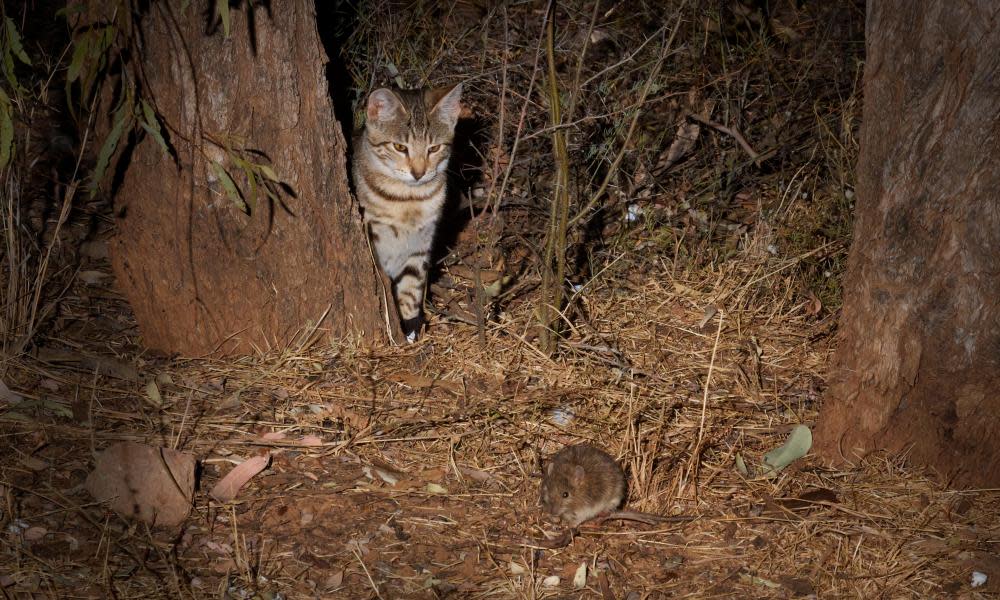Ryegrass, fire ants and feral cats: major Australian study identifies costliest pests in past 60 years

Invasive plants, animals and diseases have cost Australia at least $390bn in damages and management costs over the past 60 years, according to research that has painted the most accurate picture yet of the economic burden of these invaders.
Feral cats are the costliest of the hundreds of individual species studied, accounting for just over $10bn in damages and management expenses. Rodents, pigs and rabbits came close behind.
But the most damaging class of invasive pest is plants. Known costs to productivity and money spent managing species like ryegrass, parthenium and ragwort amounted to more than $200bn.
Related: Feral deer in the headlines: Australia’s ‘slow-moving plague’ is finally being noticed
The actual financial burden is likely to be far higher, the scientists who led the study said, because only costs reliably reported over past decades were included.
The study did not attempt to put a figure on the environmental damage from invasive species, such as the loss of biodiversity, the extinction of species or the loss of cultural values.
“The big stick in the spokes here is that we are still looking at a huge underestimate of the costs,” said Prof Corey Bradshaw, of Flinders University and the ARC Centre of Excellence for Australian Biodiversity and Heritage.
Bradshaw, who led the study, said the costs from invasive species were only likely to increase in the absence of major investment and better coordination.
In the 1970s, the average annual cost from invasive pests was $70m but in the most recent decade, this had risen to $20bn.
For New South Wales and the ACT, cats, foxes and rabbits had caused the most damage. In the Northern Territory, more than a third of the costs came from a fungus that causes banana freckle disease.
Queensland’s costliest invader, according to the study, is the red fire ant, with the potato weed the most expensive for Victoria and South Australia.
Tasmania’s biggest economic impact came from the toxic ragwort, and Western Australia’s costliest invader is ryegrass.
The study, published in the journal NeoBiota, is likely the most comprehensive yet on the observed costs from invasive pests in Australia.
But Bradshaw said there was still very large gaps in understanding. For example, there were few studies or reports documenting damage from invasive birds, mites or fish.
Dr Andrew Hoskins, a co-author of the study and research scientist at CSIRO, said there were many “known unknowns” that couldn’t be captured.
“We know for example that root rot causes huge environmental and agricultural damage, but we couldn’t find any good cost data even though we know the impact is huge,” he said.
He said while the costs and impacts were often hidden from the general public, dealing with invasive species was putting an extra burden on farmers and on food prices.
Last year, a report led by the CSIRO called for a major overhaul of the way Australia manages biosecurity threats.
Related: Pests, pathogens and pandemics: Australia's biosecurity needs an overhaul, CSIRO warns
With a rise in globalised travel and trade, the number of interceptions of potentially hazardous materials at Australia’s borders rose 50% between 2012 and 2017.
About 20 new weed species establish in Australia every year, and the broader management costs and production losses because of invasive weeds is estimated at $5bn a year, the CSIRO report said.
Andrew Cox, chief executive of the Invasive Species Council, said the study showed “the massive burden being borne by all parts of society” from pests and diseases.
Cox, who has been calling for a Productivity Commission review of the costs and benefits of acting on invasive species, said: “We are highly vulnerable – not just our natural environment but also our agricultural systems.
“The ocean boarder is a natural defence but the escalating trade and travel is exposing us to risk. There are species already here whose impacts are growing and the rates of new arrivals are growing too.”

 Yahoo Movies
Yahoo Movies 
